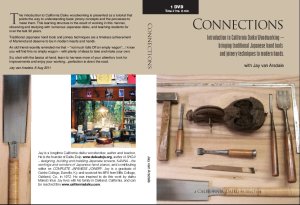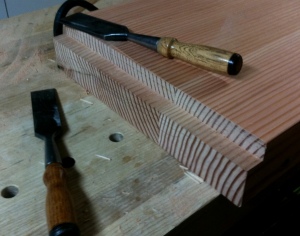A New DVD on Japanese Woodworking
When I last spoke with Jay van Arsdale to let him know our recent interview had been posted, he mentioned he had just finished up a new DVD on an introduction to Japanese joinery. Little did I know that when he told me that, a copy to review was winging it’s way (well maybe crawling, this is US Post after all) to my doorstep. So before I go any further, I want to thank Jay for sending me this complementary (and unsolicited) copy.
If you have read this blog for any amount of time you will know that I don’t know a Ryoba from Ravioli. You should also know that I am very open minded about woodworking related topics and will try anything once. So I approached this DVD as a Japanese woodworking novice. In short, it was outstanding!
The entire 2 hour plus DVD was filmed in one shot on 3 cameras. There is an honesty to the production and a zen to the atmosphere. The chirping of birds and rustle of wind through trees is just audible in the background. Sure there are some editing issues where it appears a cutaway image fades away before the underlying image is done so there are subliminal like quick shots that pop up between edits. As a podcaster on a budget (aka: no budget) I can relate to this but also identify. Here is a guy that loves what he does and wants to get his message out without relying upon expensive post production. Personally I think anyone who can talk intelligently about woodworking for 2 hours without goofing up is pretty impressive. What’s more is that Jay actually introduces tooling, marking techniques, and cuts 3 basic joints in real time all in one shot!
Japanese joinery has a reputation for being complex and highly intricate. Jay shows us the lap, bridle, and mortise and tenon joints and claims that most Japanese joinery is just a combination of these 3 joints. If you learn to cut each of them with accuracy you can combine them any number of ways to make mind boggling joinery. This principle is an excellent one that makes the entire subject suddenly very approachable. Additionally, Jay asserts that all of this work can be broken down into 5 principles:
- Rip sawing
- Crosscut sawing
- Paring
- Splitting
- Mortising
Understand how to do these 5 things and all Japanese joinery can be accomplished. This is a loaded statement certainly because much practice is needed to master these operations but regardless, the impression is a relief for the initiate. Anyone can learn 5 things right?
What struck me as most different from my own style is how Jay cuts mating pieces. He does not cut one part of the joint then traces the profile on to the mate. He relies completely on the accuracy of his layout then cuts everything and fits it together. Jay spends a lot of time on the core of this joinery method of relying upon compression across the end grain and this layout accuracy is key to getting the hammer tight fit without splitting the joint members.
The 3 joints Jay demonstrates are nothing special and joinery that most of us should know how to cut, but I still found myself riveted watching every minute detail of his process with tools foreign to me. The tips on sawing accurately with a Ryoba are worth the price of admission alone. Truly some of these tips common to Japanese woodworking cross oceans and can be employed by Western saw and chisel aficionados. For example, I went to my shop after watching this and put his splitting and paring techniques to work to cut this very large and dead square rabbet on my Joinery bench.
There are moments when the narration is a bit fast while Jay is marking out a joint, but there is gold hidden within those fast moments that needs to be rewound and watched several times over. The Japanese methods of basing everything off center lines and highly accurate, without measuring, layouts was fascinating. There is obviously a lot of experience behind Jay’s words and even the tiniest detail in this DVD has significance to someone learning the craft. The simplicity with which Jay cuts his joints without workbench holding devices and very few tools is refreshing and inspires you to get out to your shop.
Don’t get me wrong, I’m not going to run out and start buying Japanese saws and chisels just yet, but I will be back to sample from the Arsdale font of knowledge. Hey maybe Japanese woodworking can become my “hobby” since Western style has become more of my job these days.




